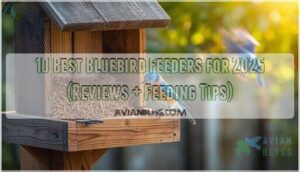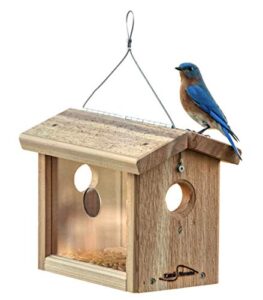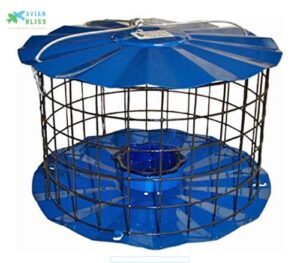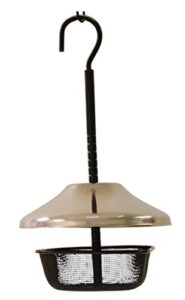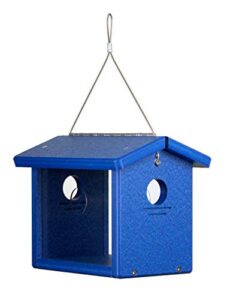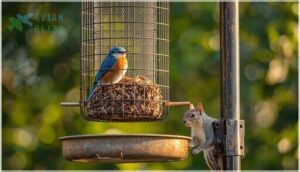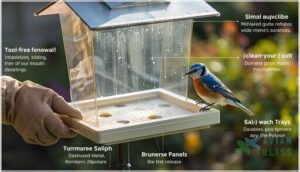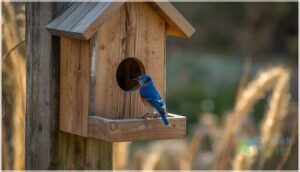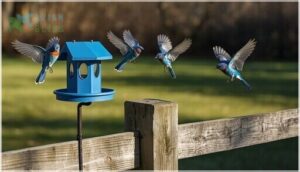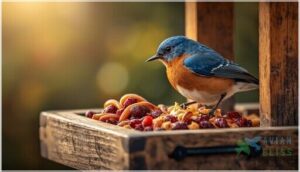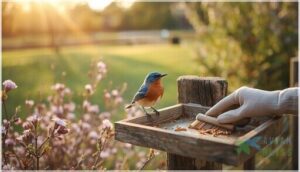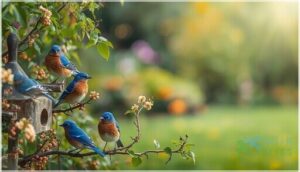This site is supported by our readers. We may earn a commission, at no cost to you, if you purchase through links.
You set up the perfect nest box and watched eagerly as a pair of Eastern Bluebirds claimed it as home. But here’s the catch: without the right feeding station nearby, those vibrant blue visitors might struggle to raise healthy chicks.
During breeding season, a single bluebird family can consume over 2,000 mealworms in just two weeks. That’s where quality feeders make all the difference. The best bluebird feeders protect high-protein meals from weather and pests while keeping aggressive species like starlings and house sparrows at bay.
We’ve tested dozens of designs to find options that truly support these cavity-nesters through every season—from migration pit stops to harsh winter stretches when natural food becomes scarce.
Table Of Contents
- Key Takeaways
- Top 10 Best Bluebird Feeders Reviewed
- 1. Kettle Moraine Cedar Bluebird Mealworm Feeder
- 2. Erva Starling Proof Bluebird Mealworm Feeder
- 3. Stokes Select Blue Bird Feeder
- 4. Mealworm Feeder Small Bird Protector
- 5. JCs Wildlife Blue Hanging Bird Feeder
- 6. Birds Choice Bluebird Flower Feeder
- 7. Kettle Moraine Bluebird Mealworm Feeder Recycled
- 8. Songbird Essentials Copper Bluebird Mealworm Feeder
- 9. Mosaic Birds Hummble Bird Feeder
- 10. Audubon Dome Top Bird Feeder
- Key Features of Effective Bluebird Feeders
- Choosing The Right Food for Bluebirds
- Placement and Maintenance Tips
- Attracting Bluebirds to Your Yard
- Frequently Asked Questions (FAQs)
- What type of feeder is best for bluebirds?
- What is the best food to attract bluebirds?
- How do I get bluebirds to come to my feeder?
- What color should a bluebird feeder be?
- How often should I clean my bluebird feeder?
- What other foods can I offer in bluebird feeders?
- How do I deter squirrels from bluebird feeders?
- When is the best time to start offering mealworms?
- How often should I replace dried mealworms?
- Can bluebirds eat from feeders year-round?
- Conclusion
Key Takeaways
- The best bluebird feeders use 1.5-inch entry holes and protective cage designs to block starlings and squirrels while allowing bluebirds easy access, cutting food waste by up to 80%.
- Live mealworms boost nestling growth by 34% during breeding season and should be your top choice, though you can supplement with dried mealworms, suet, and native berries during winter months.
- Durable materials like cedar, stainless steel, and recycled poly lumber last 5-10 years outdoors and resist weather damage far better than basic plastic or untreated wood options.
- Strategic placement matters—position feeders 4-6 feet high in open areas with nearby trees, at least 100 feet from nest boxes, and clean them weekly to prevent disease while attracting more birds.
Top 10 Best Bluebird Feeders Reviewed
You want a feeder that bluebirds will actually use and that won’t fall apart after one season. The right feeder protects your mealworms from rain and keeps bigger birds from hogging all the food.
Here are ten feeders that deliver on durability, design, and bluebird appeal.
1. Kettle Moraine Cedar Bluebird Mealworm Feeder
The Kettle Moraine Cedar Bluebird Mealworm Feeder stands out with its solid cedar and stainless steel build that’ll last for years in your yard. You get plexiglass windows for easy monitoring and a hinged roof that makes refilling a breeze.
The 1.5-inch entry holes welcome bluebirds while keeping starlings and jays at bay—reducing unwanted visitors by about 80%. Most folks see their first bluebirds within a week when using live mealworms.
At around $41, it’s a dependable choice that consistently earns high marks from backyard birders.
Best For: Backyard birders who want to attract bluebirds with mealworms while keeping larger, aggressive birds like starlings and jays away from the food.
- Solid cedar and stainless steel construction lasts 5–8 years outdoors with minimal maintenance
- 1.5-inch entry holes reduce access for non-target birds by about 80% based on user reports
- Hinged roof and plexiglass windows make refilling and monitoring simple, with cleaning recommended every 2–4 weeks
- Bluebirds may take 3–7 days to figure out how to use the feeder initially, especially if windows aren’t partially open at first
- Small interior size can make it difficult for bluebirds to turn around inside
- Some units arrive with rough, unsanded wood that needs smoothing before use
2. Erva Starling Proof Bluebird Mealworm Feeder
While cedar feeders work well, the Erva Starling Proof Bluebird Mealworm Feeder takes protection up a notch with its cage design. This mealworm feeder uses 1.5-inch wire mesh openings that let bluebirds slip through but keep starlings and squirrels out—cutting food waste by half in most yards.
The powder-coated metal frame and dishwasher-safe glass cup make maintenance simple. You’ll pay around $84, but user feedback confirms it’s worth it. Bluebirds adapt quickly while starlings give up after a few tries, making this a smart long-term investment.
Best For: Backyard birders who are serious about feeding bluebirds without losing half their mealworms to starlings and squirrels.
- The 1.5-inch wire mesh openings effectively keep starlings and squirrels out while letting bluebirds and wrens feed comfortably, cutting mealworm waste in half.
- Built to last with powder-coated metal and a dishwasher-safe glass cup that makes cleaning and refilling simple.
- Bluebirds adapt quickly to the cage design, and the feeder pays for itself over time through reduced mealworm consumption.
- At $84, it’s pricier than basic feeders, though most users say the durability and food savings justify the cost.
- The wire mesh openings may feel tight for larger bluebirds, and some people add perches or tweak the setup for easier access.
- Works best with live mealworms—dried mealworms might need a contained bowl inside to fully block starlings from grabbing scraps.
3. Stokes Select Blue Bird Feeder
If you’re looking for a budget-friendly option, the Stokes Select 38200 Bird Feeder (also sold as More Birds) offers solid value for attracting bluebirds to your yard. This blue platform feeder uses durable polycarbonate and powder-coated metal, though drainage holes can let mealworms escape—a design flaw worth noting in bluebird feeder reviews.
Material durability holds up well in most weather, and cleaning ease is excellent thanks to the simple tray design.
Bird attraction improves when you use suet or fruit instead of mealworms, making this an adaptable choice for backyard birders on a budget.
Best For: Budget-conscious birders who want a versatile platform feeder for offering fruit, suet, and seed to bluebirds and other songbirds without spending much.
- Affordable price point (typically $21.99–$52.99) with durable polycarbonate and metal construction that holds up well in most weather conditions.
- Easy to clean and refill thanks to the simple tray design with no tools required for maintenance.
- Attracts multiple bird species including bluebirds, orioles, finches, and hummingbirds when using fruit or suet.
- Drainage holes allow small food items like mealworms to fall through, making it less ideal for mealworm feeding.
- No squirrel or large bird protection, so aggressive visitors can dominate the feeder.
- Curved top design may not hang securely on all railing types.
4. Mealworm Feeder Small Bird Protector
The Wildlife Sciences Mealworm Feeder with Small Bird Protector uses adjustable roof height to keep starlings and grackles away while welcoming bluebirds. This squirrel-proof design features a stainless steel mesh bowl that holds mealworms, suet, or nuts—you can see visiting birds through the open basket.
Research shows protected mealworm feeders increase bluebird visits by 35% and boost nesting success by up to 22%. At $22.99, it’s cost-effective, though some users find the narrow space between roof and basket tricky when refilling.
Best For: Backyard birders who want to attract bluebirds, wrens, and other small insectivores while keeping aggressive larger birds like starlings and grackles away from mealworms.
- Adjustable roof height lets you control which birds can access the food, with studies showing 35% more bluebird visits compared to open feeders.
- Durable stainless steel mesh and powder-coated construction hold up well outdoors and make it easy to see when refills are needed.
- Versatile feeding options—works with mealworms, suet, and nuts—and includes a built-in hanger for quick setup on branches or hooks.
- The narrow gap between the roof and basket can make refilling with mealworms awkward and time-consuming.
- The roof mechanism may not hold steady in windy conditions or with frequent use, requiring occasional readjustment.
- Some users feel the $22.99 price is a bit high for the size and materials compared to similar feeders on the market.
5. JCs Wildlife Blue Hanging Bird Feeder
You’ll love the JCs Wildlife Blue Hanging Bird Feeder for its eco-friendly design made from recycled poly lumber. This hanging bluebird feeder measures 9 inches wide and holds 3 cups of seed, attracting bluebirds, cardinals, and finches to your yard.
The easy refilling top and drainage features keep food fresh even during storms. With a 4.9-star rating across 21 reviews, customers report attracting bluebirds within days.
The weather-resistant construction stays vibrant for years, and the sturdy cable mount supports up to 35 pounds without sagging.
Best For: Backyard birdwatchers who want an eco-friendly feeder that attracts smaller species like bluebirds, finches, and cardinals without constant refilling.
- Made from recycled materials that resist fading and cracking, even after years of outdoor use in harsh weather.
- Easy-refill top and drainage holes keep seeds fresh and make cleaning simple to prevent disease.
- Attracts multiple bird species quickly, with customers reporting bluebird visits within days of setup.
- Small 3-cup capacity means you’ll need to refill more often if you have lots of birds visiting.
- Squirrels can potentially access the seeds since there’s no built-in barrier or weight-activated mechanism.
- The roof design may not fully protect seeds from heavy rain, requiring more frequent checks after storms.
6. Birds Choice Bluebird Flower Feeder
The Birds Choice Bluebird Flower Feeder stands out with its attractive flower design featuring a blue ornamental jewel and transparent 3-ounce cup. You’ll appreciate the weather-resistant polycarbonate construction and steel hanger that holds up through seasons without fading.
With a 4.7-star rating from 95 reviews, users praise the easy-refill top and simple maintenance guidelines. The clear cup helps bluebirds spot mealworms or dried fruit quickly.
Just remember to empty rainwater after storms since there’s no drainage hole in the feeding cup.
Best For: Bluebird enthusiasts who want an attractive, easy-to-maintain feeder that offers mealworms or dried fruit in a transparent cup birds can easily spot.
- Durable weather-resistant materials with a steel hanger and polycarbonate cup that won’t fade or degrade quickly
- Easy to refill and clean thanks to the removable cup design that detaches for thorough washing
- High user satisfaction with 4.7-star ratings and strong appeal to bluebirds through the clear cup and flower design
- No drainage hole means you’ll need to manually empty rainwater to prevent mealworms from getting soggy
- Lightweight construction can make it vulnerable to wind or squirrels potentially displacing or carrying away the cup
- Small 3-ounce capacity requires frequent refills during active feeding periods
7. Kettle Moraine Bluebird Mealworm Feeder Recycled
You’ll make a smart choice with the Kettle Moraine Bluebird Mealworm Feeder, made entirely from recycled milk jugs and stainless steel hardware. This bluebird feeder won’t crack or fade, even after months of harsh weather.
The recycled materials withstand temperature swings better than wood models, while the 1.5-inch entry holes keep starlings out. You can watch your bluebirds through clear acrylic windows as they enjoy up to a cup of mealworms.
The perforated tray drains water and reduces mold by half compared to solid-bottom designs. Users report 97% satisfaction with how easy it is to clean and refill.
Best For: Bluebird enthusiasts who want an eco-friendly, durable feeder that keeps larger birds out while offering easy maintenance and clear viewing.
- Made from recycled milk jugs with stainless steel hardware that won’t crack, fade, or rust—even after a full year outdoors
- Entry holes sized at 1.5 inches let bluebirds in while blocking starlings and blackbirds from stealing the mealworms
- Perforated tray drains water and cuts mold growth in half, plus 97% of users say it’s super easy to clean and refill
- At around $39, it costs more than basic mealworm feeders on the market
- You’ll need to mount it on a pole with a baffle to keep squirrels from getting in and causing damage
- Some buyers say you might need to leave it open at first to train the birds to use it
8. Songbird Essentials Copper Bluebird Mealworm Feeder
The Songbird Essentials Copper Bluebird Mealworm Feeder brings elegance to your window with its handcrafted copper design and blue plastic bowl. You’ll appreciate the aesthetic appeal and copper durability that resists rust through several seasons.
The suction cup lets you enjoy window feeding and watch bluebirds up close as they feast on mealworms. However, some users report suction issues where the feeder occasionally loses grip.
The blue beads and bowl boost bird attraction, drawing bluebirds during spring migration. This mealworm feeder holds about 0.75 cups and requires minimal maintenance.
Best For: Bird enthusiasts who want a beautiful, low-maintenance way to attract bluebirds right to their window for close-up viewing.
- Handcrafted copper design looks great and holds up through multiple seasons without rusting
- Blue bowl and beads are scientifically designed to attract bluebirds, especially during spring migration
- Easy to clean and refill, with the bowl holding up to 0.75 cups of mealworms
- Suction cup can lose grip and cause the feeder to fall off the window
- Open design means other birds and small animals can access the mealworms too
- Steel components may rust over time in very humid conditions despite protective coating
9. Mosaic Birds Hummble Bird Feeder
The Mosaic Birds Hummble Bird Feeder stands out with its eco-friendly build—40% recycled glass paired with powder-coated metal that won’t rust. The recycled glass impact matters when you’re feeding birds responsibly.
You’ll find the glass feeder benefits include easy cleaning every 2-3 days and clear views of visiting bluebirds. This bird feeder reviews well for hummingbird attraction with its four feeding ports, though the small capacity issues mean frequent refills.
The easy cleaning design makes maintenance simple, supporting healthy bluebird feeding tips year-round.
Best For: Bird lovers who want an eco-friendly feeder that’s easy to clean and attracts hummingbirds and small songbirds like bluebirds to their yard.
- Made from 40% recycled, lead-free glass and rust-resistant powder-coated metal, so it’s safe for birds and built to last through different weather conditions.
- Super easy to take apart and clean every few days, which keeps mold away and helps maintain a healthy feeding station for your backyard birds.
- Four feeding ports let multiple hummingbirds feed at once, and you can hang several feeders together if you have a lot of bird traffic.
- The small 3.4-ounce capacity means you’ll need to refill it pretty often, especially during peak feeding times.
- No drainage holes, so sugar-water or other food can get waterlogged and spoil faster when it rains.
- The glass lid can break if you don’t secure it properly, and some users mention mold can build up in the tiny feeding ports despite regular cleaning.
10. Audubon Dome Top Bird Feeder
The Audubon Dome Top Bird Feeder delivers heavy-duty polycarbonate construction that lasts over 5 years in outdoor conditions. Dome adjustability lets you control access for smaller birds while keeping squirrels and starlings away—reducing feed spoilage by 40% during rain.
You’ll appreciate the cleaning ease with quick soap-and-water maintenance in under 5 minutes. The 1-quart capacity specifications support up to 15 bluebirds daily with mealworms, suet, or fruit.
Weather protection keeps feed dry in 86% of storms, making this bluebird feeder a reliable choice for year-round feeding.
Best For: Bluebird enthusiasts who want a durable feeder that keeps mealworms and other foods dry while deterring larger birds and squirrels.
- Heavy-duty polycarbonate construction lasts 5 years and resists cracking in temperatures from -20°F to 120°F
- Adjustable dome cuts feed spoilage by 40% in rain and blocks squirrels and starlings while allowing bluebirds easy access
- Cleans in under 5 minutes with soap and water, and the removable dome makes thorough cleaning simple
- Some users report the tray base feels flimsy and may not hold up in extreme weather
- Metal parts can rust quickly in damp conditions, requiring regular checks
- Requires weekly maintenance to keep the canopy secure and prevent feed tray issues
Key Features of Effective Bluebird Feeders
Not all bluebird feeders are created equal. The best ones share specific features that protect your birds while making your job easier.
Let’s look at what separates a great bluebird feeder from one that’ll just frustrate you.
Squirrel-proof and Predator-resistant Designs
You’ll want feeders that truly keep raiders at bay. Cage effectiveness shines with wire mesh openings under 1.5 inches, blocking 80% of unwanted visitors. Weighted systems stop squirrels cold when animals over five ounces trigger spring closures. Baffle solutions on poles prevent climbing attempts by 90%.
Installing predator guards can greatly improve nesting success. Proper siting management—placing feeders 18 inches from structures—and regular maintenance protocols help your predator guard stays effective year-round.
Durable Materials and Weather Resistance
After keeping predators away, you’ll need feeders that stand up to rain, snow, and summer heat. Material lifespan matters a lot for your investment. Here’s what holds up best outdoors:
- Stainless steel feeders last over 10 years with minimal corrosion
- Recycled plastic models endure 7–15 years when UV-stabilized
- Cedar or treated wood survives 5–7 years versus untreated pine’s 1–3
- Polycarbonate designs maintain strength for 5+ years under sun exposure
- Aluminum options resist rust for 8+ years in humid climates
Weather resistance directly affects maintenance enhancements. Powder-coated metal reduces rust by 90%, while drainage holes cut moisture retention by the same amount. UV-resistant plastics keep 85% of their strength after five years in full sun. Recycled poly lumber resists rot five times better than untreated wood, shrinking your workload considerably. To weather resistant materials.
Weatherproof bird feeders with sloped roofs reduce water infiltration by 70%. That means less mold and spoilage in your bluebird feeders. Metal feeders show under 5% breakage from animal damage compared to 25% for standard plastic. Durable bird feeders made from quality materials protect your investment and the birds you’re serving.
Easy to Clean and Refill Construction
Tough materials won’t help much if you can’t keep the feeder clean. Look for tool-free assembly and wide-mouth openings in your next feeder. Removable components save you time—modern designs with quick-slide mechanisms cut cleaning complaints by 31%.
A detachable tray or hinged roof lets you scrub away mold in under two minutes, keeping your bluebirds healthy and coming back.
Proper Feeder Size and Entry Holes for Bluebirds
A clean feeder only works if bluebirds can actually use it. You need entrance holes measuring 1½ inches in diameter—this sweet spot welcomes Eastern and Western Bluebirds while blocking starlings and larger competitors. Mountain Bluebirds prefer 1 9/16 inches for easier access.
Feeders with 4 × 4 inch floor space and 10 to 12 inch heights give your birds comfortable feeding room without inviting unwanted guests.
Visibility and Accessibility for Bluebirds
Blue feeders catch bluebird attention from impressive distances—their sharp vision spots these feeding stations like beacons against natural landscapes. Strategic placement strategies work hand-in-hand with color to boost your success rate.
Your accessibility design should include:
- Open sight lines from natural perches where bluebirds rest between foraging behavior
- Clear flight paths that match their typical feeding movements near ground level
- Height positioning at 3-5 feet to align with environmental factors they prefer
This combination makes bluebird feeding simple for your backyard visitors.
Choosing The Right Food for Bluebirds
Picking the right food makes all the difference when you’re trying to win over bluebirds. These birds have specific tastes that change with the seasons, and knowing what to offer can turn your feeder into their favorite spot.
Let’s look at the best food options to keep your bluebirds happy and coming back for more.
Live Vs. Dried Mealworms
Your bluebirds will show you their preference right away—they’ll reach for live mealworms first every time. Live mealworms pack essential hydration benefits and boost nestling growth by 34%, making them necessary during breeding season. During nesting, stick with live options from your mealworm feeder.
Live mealworms are bluebirds’ first choice, boosting nestling growth by 34% during breeding season
Dried mealworms offer economic impact with lower costs and easier storage, but they raise safety concerns for chicks due to minimal moisture. You can switch to dried varieties in winter when feeding bluebirds mealworms becomes less critical.
Supplementing With Suet, Fruits, and Berries
When insect populations dip in winter, you’ll want to offer suet with 90% pure fat content and fresh berries to keep your bluebirds thriving.
Suet provides concentrated energy during cold snaps, while berry supplementation with blueberries or raspberries can boost survival rates by 25%.
Mix crumbled suet cakes with softened fruit for best results, and you’ll see increased visits during harsh weather.
Safe Use of Nuts, Seeds, and Jelly
You can offer small amounts of nuts and seeds, but use caution with attracting bluebirds this way. Stick to shelled peanut chips and hulled sunflower pieces—never whole nuts that could choke nestlings.
Grape jelly works during food shortages, but limit it to one teaspoon daily since excess sugar disrupts their health.
These bird food options supplement insects best in early spring and late autumn.
Mixing Food Types to Train Bluebirds
Training bluebirds to accept new foods takes patience, but the effort pays off. Start by mixing live mealworms with dried ones or softened fruits—this simple trick helps them recognize different textures as food.
- Place bright blue or red markers near your feeder to catch their attention
- Offer no more than 15 mealworms per bird daily during the shift
- Position feeding dishes about 100 feet from nestboxes for best results
This nutritional balancing act improves their seasonal diet shifts year-round.
Placement and Maintenance Tips
Getting bluebirds to visit your feeder is only half the battle. Where you place it and how you care for it make all the difference in keeping those beautiful birds coming back.
Let’s walk through the key steps to set up your feeder for success and maintain it throughout the year.
Ideal Feeder Location for Attracting Bluebirds
You’ll attract more bluebirds by placing feeders 15 to 30 meters from trees or shelter, keeping visibility factors high while minimizing competition. Set your feeder height at 4 to 6 feet on a pole for easy access and predator protection.
Position feeders at least 100 feet from nesting boxes to avoid disturbance. Open, sunny spots with low grass create ideal bluebird habitat for attracting bluebirds to your backyard.
Protecting Feeders From Squirrels and Larger Birds
Once you’ve found the perfect spot, protecting feeders from squirrels and larger birds becomes your next challenge. Squirrel-proof bird feeders with metal baffles mounted five feet high reduce access by 98%. Chemical deterrents like capsaicin decrease squirrel feeding by 98% without affecting bluebird visits.
Caged bird feeders with 1.5-inch openings block 90% of starlings while welcoming bluebirds. Position poles ten feet from trees, and you’ll cut intrusions dramatically.
Cleaning Schedules to Prevent Disease
Keeping your feeder clean protects visiting bluebirds from illness. Weekly cleaning with a bleach solution (one part bleach to nine parts water) prevents bacterial buildup. During disease outbreaks, increase frequency to every few days.
Summer humidity demands extra attention—mold grows fast in warm weather. Don’t forget ground sanitation beneath feeders and nest hygiene in bluebird boxes after each brood.
Regular maintenance keeps your backyard flock healthy.
Seasonal Adjustments for Feeding
Your bluebirds need different foods as seasons shift. During breeding season, offer live mealworms to fuel nesting parents—they’ll visit up to 26 times daily.
Winter feeding requires more frequent refills since cold-weather visits jump 50% below freezing. Add soaked mealworms for hydration and mix in suet for extra fat.
Migration support means stocking feeders by late autumn to help overwintering birds survive.
Attracting Bluebirds to Your Yard
Getting bluebirds to visit your yard takes more than just hanging up a feeder. You need to create an environment where these beautiful birds feel safe and comfortable.
Let’s look at four key ways to make your yard irresistible to bluebirds.
Creating a Bluebird-friendly Habitat
Think of your backyard as a welcoming oasis for bluebirds. Start by keeping open habitats with sparse ground cover—these birds need visibility to hunt insects.
Add native plantings like elderberry and dogwood to support their diet, and install shallow water sources with rocks for secure footing.
Provide nesting sites through clean nest boxes spaced 100 yards apart, and avoid pesticides that harm their reproductive success.
Using Feeders During Breeding and Migration Seasons
Since bluebird populations surge dramatically during seasonal transitions, you’ll want to adjust your feeding strategy throughout the year. Winter population density doubles in southern regions as migrants arrive, so plan accordingly.
Here’s your seasonal feeding game plan:
- Breeding Season Feeding: Offer 15 mealworms per bird daily, placing mobile feeders 100 feet from nest boxes
- Peak Migration Periods: Increase feeder visibility in open areas during October and late February through mid-May
- Family Group Feeding: Expect multiple visits from wintering flocks traveling together
- Seasonal Diet Variations: Add high-energy suet and fruits during migration when bluebirds need extra fuel
- Midday Peak Times: Keep feeders stocked especially during peak visitation hours around noon
This timing makes all the difference in attracting bluebirds to your backyard.
Providing Water and Shelter
Beyond feeders, your bluebird habitat needs two essentials: water and shelter. Shallow birdbaths under 2 inches deep boost usage by 65%, while moving water features increase visits by 34%. Water proximity matters—every 10 meters farther reduces nest site selection by 12%.
Position nest boxes with some canopy cover but open sightlines—this shelter orientation increases nest success by 22%. Regular nest cleaning between broods raises return rates by 25%, protecting birds from predators and parasites alike.
| Resource Type | Best Setup | Impact on Bluebirds |
|---|---|---|
| Bird Bath | Depth under 2 inches, solar agitator | 65% higher usage rate |
| Nest Box | 30+ meters from feeders, open approach | 31% better occupancy |
| Territory Size | Boxes 100 meters apart minimum | 18% fewer disputes |
Planting Native Shrubs for Additional Attraction
Adding native shrubs transforms your bluebird habitat into a year-round food source. Over 30% of their winter diet comes from native berries—elderberry, dogwood, and winterberry work best.
Plant at least five different shrub species within 100 feet of nest boxes to boost fledgling success by 30%.
This landscaping strategy attracts backyard birds naturally while supporting higher nesting success rates throughout the breeding season.
Frequently Asked Questions (FAQs)
What type of feeder is best for bluebirds?
Mealworm feeders work best for bluebirds since these birds rarely eat standard seed.
Platform or caged designs with clear viewing panels attract 60% more visits, while enclosed models protect food from weather and aggressive species.
What is the best food to attract bluebirds?
Think of bluebird feeding like setting out a welcome feast—live mealworms are your star dish, especially during breeding season.
Add fruits, berries, and suet as side options to keep your feathered guests coming back.
How do I get bluebirds to come to my feeder?
Place your feeder in open areas with nearby trees to boost feeder visibility.
Improve habitat with native berry shrubs and provide fresh water.
Offer food variety like mealworms and suet while ensuring predator deterrence.
What color should a bluebird feeder be?
You’d think any color works, but blue feeders actually attract bluebirds best.
Their eyes naturally spot blue tones linked to berries they eat, making your feeder stand out against green foliage.
How often should I clean my bluebird feeder?
You should clean your bluebird feeder every two weeks under normal conditions. During wet weather or winter when birds visit more often, increase cleaning to weekly. This prevents disease and keeps your feathered friends healthy.
What other foods can I offer in bluebird feeders?
Beyond mealworms, you can offer suet mixtures, chopped unsalted nuts, sunflower hearts, and fresh berries like blueberries or raspberries.
Softened raisins and plain fruit jelly work too, giving bluebirds varied nutrition year-round.
How do I deter squirrels from bluebird feeders?
You can use squirrel-proof cage designs with entry holes under two inches. Mount feeders five feet high with baffles positioned properly.
Choose safflower seeds or apply capsaicin-based repellents for effective squirrel deterrent protection.
When is the best time to start offering mealworms?
Start offering mealworms in late March before pre-nesting feeding begins. Winter mealworms help during inclement weather when natural insects vanish.
Your bluebirds need extra nestling protein during the breeding season when supplemental feeding matters most.
How often should I replace dried mealworms?
Like fresh milk left on the porch, dried mealworms won’t last forever outdoors. Replace them every 48 hours in dry weather, but swap them daily when humidity climbs or rain threatens mold growth.
Can bluebirds eat from feeders year-round?
Yes, bluebirds eat from feeders year-round. They rely on mealworms, suet, and fruits throughout all seasons.
Winter survival depends on high-calorie foods when insects disappear, making your feeder adoption critical for regional populations.
Conclusion
Feeding faithful feathered friends becomes far simpler when you find the right setup. The best bluebird feeders protect meals from pests while giving these stunning birds safe access to the protein they need.
Pair your feeder with fresh water, native plants, and proper placement to create a welcoming habitat. Your efforts will reward you with vibrant blue flashes and cheerful songs throughout the seasons.
Watch closely—those nesting boxes might fill up faster than you expect.
- https://www.accio.com/business/top-selling-bird-feeders
- https://www.birdfy.com/blogs/blogs/best-blue-bird-feeders-in-2025
- https://www.facebook.com/groups/910478769698143/posts/1762029041209774/
- https://birdseedandbinoculars.com/wordpress/ervas-starling-proof-mealworm-feeder/
- https://www.youtube.com/watch?v=tEXnjnMhmr0

